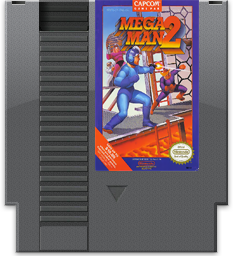

Mega Man 2, developed and published by Capcom, is an iconic video game that cemented the franchise's position as one of the most beloved platforming series of all time. Originally released in 1988 for the Nintendo Entertainment System (NES), Mega Man 2 builds upon its predecessor's foundation and delivers an unforgettable experience filled with exhilarating action, memorable bosses, and a fantastic soundtrack. Even after decades, this game remains a shining example of timeless gameplay and showcases why Mega Man is a household name.
Year: 1989
Manufacturer: Capcom
Genre: Platform
Rating: HSRS - GA (General Audience)
Cover art: In 1989 the cover art of many Video Games were better than the pixelated graphics could convey. In this case, the inverse is true. The cover art is horrendous. The Mega Man on the cover of the NES game was replaced by the cartoon Mega Boy we know and love today.
Gameplay:
Mega Man 2 retains the fundamental mechanics that made its predecessor great while introducing notable improvements. Players once again control the Blue Bomber as he traverses a series of challenging stages, defeating Robot Masters and acquiring their unique weapons. The platforming elements are tight and responsive, demanding precise jumps and swift reflexes. Each stage is thoughtfully designed, incorporating clever level hazards, tricky enemy placements, and hidden secrets.
The highlight of Mega Man 2 lies in its iconic boss battles. The eight Robot Masters, including memorable foes like Metal Man and Bubble Man, each possess distinct attack patterns and weaknesses. Players can strategize and defeat them in any order they desire, adding a layer of non-linear gameplay that enhances replayability. Acquiring a defeated boss's weapon grants Mega Man new abilities, which can be advantageous against specific bosses or environmental obstacles, encouraging experimentation and strategic thinking.
Visuals and Sound:
For an NES game, Mega Man 2's visuals are exceptional. The sprite work is vibrant and detailed, with each stage having a distinct visual theme that complements its corresponding Robot Master's design. The game's graphical fidelity is further enhanced by smooth animations and excellent use of color. The attention to detail is evident, and the iconic character designs of Mega Man and the bosses have become legendary in gaming culture.
One aspect that truly elevates Mega Man 2's immersive experience is its exceptional soundtrack. Composed by Takashi Tateishi, the game's music is a masterpiece, with each stage featuring its own catchy and memorable tune. From the energetic beats of "Metal Man" to the haunting melodies of "Dr. Wily's Castle," the music enhances the atmosphere and heightens the excitement of every level. Even today, the soundtrack remains an integral part of the Mega Man franchise's legacy.
Legacy and Impact:
Mega Man 2's impact on the gaming industry cannot be overstated. It solidified the franchise's formula, laying the groundwork for future iterations while capturing the hearts of millions of players worldwide. Its success led to numerous sequels, spin-offs, and an enduring legacy that continues to thrive today. The Mega Man series owes much of its popularity to the exceptional gameplay, level design, and memorable boss battles introduced in Mega Man 2.

Conclusion:
Mega Man for the NES remains a timeless gem in the world of video games. Its solid gameplay, memorable characters, and ingenious boss system make it a must-play for any retro gaming enthusiast. Whether you're a fan of challenging platformers or simply appreciate gaming history, Mega Man deserves a spot in your collection. It's a testament to the creative brilliance of Capcom and the enduring legacy of one of gaming's most iconic franchises.
Explore in-depth reviews and analyses of classic Nintendo Entertainment System (NES) games, including gameplay mechanics, graphics, sound, and overall nostalgic experience.